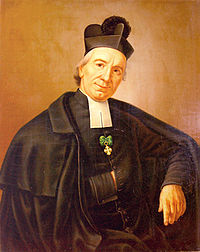Saint Giuseppe Benedetto Cottolengo
| Saint Joseph Benedict Cottolengo | |
|---|---|

Portrait by his brother, Agostino
|
|
| Confessor | |
| Born |
3 May 1786 Bra, Province of Cuneo, Piedmont, Kingdom of Sardinia |
| Died | 30 April 1842 (aged 55) Chieri, Province of Turin, Piedmont, Kingdom of Sardinia (now Italy) |
| Venerated in | Roman Catholic Church |
| Beatified | 1917 by Pope Benedict XV |
| Canonized | 1934, Rome by Pope Pius XI |
| Feast | 30 April |
Saint Giuseppe Benedetto Cottolengo or Saint Joseph Benedict Cottolengo (3 May 1786 – 30 April 1842) was the founder of the Little House of Divine Providence and is a saint of the Roman Catholic Church.
Joseph Benedict Cottolengo was born 3 May 1786 into a middle class family, in Bra, then in the Kingdom of Sardinia. The eldest of twelve children, (six of whom died in infancy), on 2 October 1802 he became a Franciscan tertiary. In 1805 he entered the seminary at Asti. Two years later it was closed, and he was forced to continue his studies at home. Cottolengo was ordained a priest 8 June 1811.
Assigned as a curate to Corneliano D'Alba, he completed his doctorate in theology in Turin and in 1818 was accepted as a canon of the Basilica of Corpus Domini in Turin. Canon Cottolengo donated all his gifts, donations, fees for preaching, and Mass stipends to the poor.
At the time, Turin was still recovering from the French occupation and under the pressure of intense immigration from the countryside, which caused serious social problems and poverty. The city was rife with pauperism and beggary, illiteracy and recurrent epidemics, numerous illegitimate births and high infant mortality. At the age of forty-one, after reading the life of St. Vincent de Paul, he came to understand that his true vocation was that of charity.
At this time Father Cottolengo attended a family traveling from Lyons to Milan. The pregnant mother was ill and was not accepted at the Maggiore Hospital because she had tuberculosis. Neither could she go to the maternity hospital because she was ill with fever, and the regulations proscribed admitting anyone who might be infectious. Cottolengo gave the mother last rites and baptized her child before it died. Affected by the scene and the cries of her surviving children, Cottolengo went and sold everything he owned, including his cloak, and rented two rooms. He began his new work on 17 January 1828, offering free accommodation to an elderly paralytic. Before long the premises turned into a hospitality center for people who were not accepted in hospitals. He came to be assisted by Doctor Lorenzo Granetti, pharmacist Paul Royal Anglesio and twelve "Ladies of Charity", under the direction of the rich widow Marianna Nasi, who visited the sick.
...
Wikipedia
